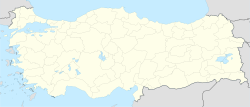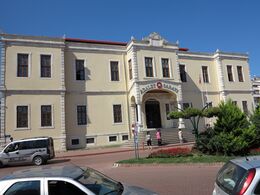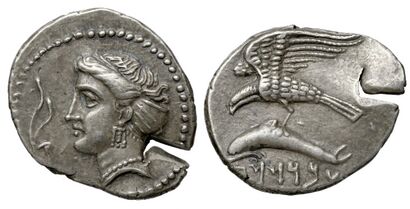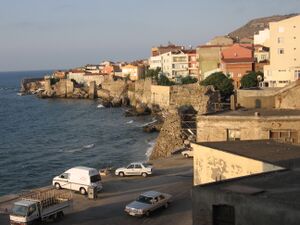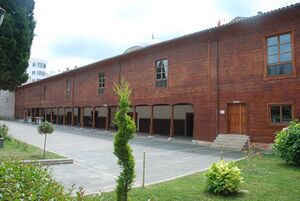سينوپ
سينوپ
Sinop | |
|---|---|
 كولاج صورة من سينوپ، تركيا. Top left: view of Sinop North Wall, nearby Demirci and Bezirci area; top right: Sinop Fortress and Port of Sinop; middle right: View of Plaj Yolu, nearby Sinop Anadolu Imam Hatip College from Baris Manco Park; bottom left: Panorama view of downtown Sinop, from Hippodrome Hill; bottom right: Hamsilos resort area | |
| الإحداثيات: 42°02′N 35°09′E / 42.033°N 35.150°E | |
| البلد | |
| المنطقة | البحر الأسود |
| المحافظة | سينوپ |
| Districts | 9 |
| الحكومة | |
| • العمدة | Baki Ergül (حزب الشعب الجمهوري, CHP) |
| • المحافظ | Dr.Yasemin ÖZATA ÇETİNKAYA |
| المساحة | |
| • District | 438٫58 كم² (169٫34 ميل²) |
| التعداد (2012)[2] | |
| • Urban | 38٬571 |
| • District | 57٬399 |
| • كثافة District | 130/km2 (340/sq mi) |
| منطقة التوقيت | UTC+2 (EET) |
| • الصيف (التوقيت الصيفي) | UTC+3 (EEST) |
| الرمز البريدي | 57xxx |
| مفتاح الهاتف | (+90) 368 |
| Licence plate | 57 |
| Climate | Cfa |
| الموقع الإلكتروني | www.sinop.bel.tr |
سينوپ (باليونانية: Σινώπη, Sinópi) هي مدينة على برزخ إنجى بورون (إنجىبورون، رأس إنجى) وعلى شبه جزيرة بوز تپه، بالقرب من رأس سينوپ (سينوپ بورنو، بوزتپه بورنو) الواقعة على الطرف الشمالي للساحل التركي للبحر الأسود، في منطقة پافلاگونيا القديمة. وهي عاصمة محافظة ومقاطعة سينوپ في تركيا.[3] ويبلغ تعداد سكانها 57,404 نسمة (في 2022).[4] وتقع في منتصف الساحل الشمالي للأناضول على البحر الأسود.
التاريخ
Over a period of approximately 2,500 years, Sinope has at various times been settled by Colchians, Greeks (in the late 7th, late 5th, and 4th–3rd centuries BC), by Romans in the mid-1st century BC, and by Turkic people beginning in the 12th century. In the 19th and 20th centuries it was also settled by the muhacir who immigrated from the Balkans and Caucasus.[5]
Evidence for Hittite Kingdom settlement along the Black Sea's southern shore remains murky. Researchers in the 1940s and 50s debated whether the "Great Sea", mentioned on the Boghazkoy tablets describing war between the Kizzuwatna tribe and the Hittites, could mean the Black Sea. Albrecht Goetze argued that the Hittites had never reached the northern Black Sea shore, instead drawing the northernmost boundary of the Hittite Kingdom to the south of the North Anatolia mountain range. D.S. Hogarth similarly concluded that the northern boundary of the Hittites never reached the shore. Hogarth's boundary was based on the distribution of Hittite monuments. Some objects found at Sinope are believed to be of Hittite origin.[6]
The Greek colony of Sinope (باليونانية: Σινώπη) was founded by Ionians from the city of Miletus.[7] Sinope issued its own coinage, founded colonies, and gave its name to a red earth pigment called sinopia, which was mined in Cappadocia for use throughout the ancient world.[8] Some scholars have dated the earliest Greek colonization of Sinope to the 7th c. BC, while others have proposed an earlier date in the 8th c. While literary evidence exists supporting earlier settlement, archaeological evidence has been found of Greek settlement around the Black Sea region beginning in the late 7th century.[9][10]
Sinope was strategically located among the trade routes that were developing on the southern Coast of the Black Sea, but remained relatively isolated from other inland communities until the 4th century BC.[5][11] There is literary evidence of early links between Colchis and Sinope in mythological tradition. Strabo's writings link the legendary founder of Sinope, Autolycus, with Jason and the Argonauts. Polybius described Sinope as being "on the way to Phasis".[12] The Persian Achaemenid Empire's northward expansion in the 4th century disrupted Sinope's control over its eastern colonies, including Trapezus (present day Trabzon). The satrap Datames briefly occupied the city around 375 BC.[13][14] There is archaeological evidence of increased economic activity between the port city of Sinope and the surrounding inland areas during between 4th and 1st c. BC. Sinope appears to have maintained its independence from the dominion of Alexander the Great, and with the help of Rhodes turned back an assault led by Mithridates II of Pontus in 220 BC. Sinope eventually fell to Pharnaces I in 183 BC, after which it became the capital of the Pontic Kingdom.[5][14]

The Roman general Lucullus conquered Sinope in 70 BC, and Julius Caesar established a Roman colony there, Colonia Julia Felix, in 47 BC. Mithradates Eupator was born and buried at Sinope, and it was the birthplace of Diogenes, of Diphilus, poet and actor of the New Attic comedy, of the historian Baton, and of the Christian heretic of the 2nd century AD, Marcion.
After the division of the Roman Empire in 395, Sinope remained with the Eastern Roman Empire. Its history in the early Byzantine period is obscure, except for isolated events: it was used by Justinian II as a base from which to reconnoitre Cherson, participated in the rebellion of the Armeniac Theme in 793, was the site of Theophobos' proclamation as emperor by his Khurramite troops in 838, and suffered its only attack by the Arabs in 858.[15]
In 1081, the city was captured by the Seljuk Turks, who found there a sizeable treasury, but Sinope was soon recovered by Alexios I Komnenos, ushering a period of prosperity under the Komnenian dynasty.[15] After the sacking of Constantinople by the Fourth Crusade in 1204, it was captured for the Empire of Trebizond by David Komnenos, until the Seljuk Turks of Rûm successfully captured the city in 1214.[15][16] The city returned briefly to Trapezuntine rule in 1254, but returned to Turkish control in 1265, where it has remained since.[15]
After 1265, Sinop became home to two successive independent emirates following the fall of the Seljuks: the Pervâne and the Jandarids. During his march on Trebizond, the Ottoman Sultan Mehmet II overawed Ismail, the emir of Sinop, and forced him to surrender the city without a fight. Mehmet took possession in late June 1461, exiling Ismail to Philippopolis (modern Plovdiv) in northern Thrace.[17]
Ibn Battuta visited the city and stayed for about forty days. He noted it was "a superb city which combines fortification with beautification."[18]
In 1614, Sinop was targeted by Cossack raiders and extensively looted and burned in an event which shocked Ottoman contemporaries.[19]
In November 1853, at the start of the Crimean War, in the Battle of Sinop, the Russians, under the command of Admiral Nakhimov, destroyed an Ottoman frigate squadron in Sinop, leading Britain and France to declare war on Russia.
In the late 19th and early 20th century, Sinop was part of the Kastamonu Vilayet of the Ottoman Empire.
As of 1920, Sinop was described as populated mainly by Greeks with an approximate population of 8,000. It was also considered the "safest" port "between Bosphorus and Batum", at the time. During this period, the port was exporting wheat, tobacco, seeds, timber and hides. They imported produce, coal and hardware.[20] The Greek inhabitants left in 1923 after the Population Exchange between Greece and Turkey, with many settling in Nea Sinopi.
Sinop hosted a US military base and radar that was important for intelligence during the Cold War era.[21] The US base was closed in 1992.
Explorer Robert Ballard discovered an ancient ship wreck north west of Sinop in the Black Sea and was shown on National Geographic.
العملات

Greek coins featuring an eagle holding a dolphin or marine animal in its talons have been found in Sinope, Istria and Olbia. Located in present-day Turkey, Romania and Ukraine respectively, all three were colonies of Miletus. The coins circulated between c. 450 and 325 BC.[22] Coins of the "Sinope type" continued to be issued by Persians under Achaemenid rule in the 4th century BC. At least two Persian issuers of such coins have been studied in some detail: the satrap Datames in Cappadocia and Ariarathes.[23]
الجغرافيا
Sinop is located on a promontory at the narrowest point of the Black Sea. It has two harbors and is located along the southern shore of the Black Sea, near the shortest crossing to the Crimea. The nearby mountainous terrain is green and noted for its timber.[5][14]
المناخ
Sinop has a humid subtropical climate (Köppen: Cfa, Trewartha: Cf).
Sinop has warm summers with an average daytime high of 26 °C (79 °F), and temperatures rarely exceed 30 °C (86 °F). The winters are cool and wet, the average for February is just below 7 °C (45 °F). Snowfall is occasional December to March, sometimes lasting a week or two.
| أخفClimate data for سينوپ، تركيا (1991–2020، القصوى 1936–2020) | |||||||||||||
|---|---|---|---|---|---|---|---|---|---|---|---|---|---|
| Month | Jan | Feb | Mar | Apr | May | Jun | Jul | Aug | Sep | Oct | Nov | Dec | Year |
| Record high °C (°F) | 22.8 (73.0) |
25.0 (77.0) |
29.3 (84.7) |
32.0 (89.6) |
33.6 (92.5) |
33.2 (91.8) |
34.5 (94.1) |
39.3 (102.7) |
34.0 (93.2) |
34.0 (93.2) |
27.9 (82.2) |
27.4 (81.3) |
39.3 (102.7) |
| Mean daily maximum °C (°F) | 9.7 (49.5) |
9.8 (49.6) |
11.3 (52.3) |
14.5 (58.1) |
19.0 (66.2) |
24.0 (75.2) |
26.8 (80.2) |
27.6 (81.7) |
24.1 (75.4) |
19.9 (67.8) |
15.6 (60.1) |
12.0 (53.6) |
17.9 (64.2) |
| Daily mean °C (°F) | 7.1 (44.8) |
6.8 (44.2) |
8.1 (46.6) |
11.0 (51.8) |
15.5 (59.9) |
20.5 (68.9) |
23.6 (74.5) |
24.3 (75.7) |
20.8 (69.4) |
16.9 (62.4) |
12.6 (54.7) |
9.2 (48.6) |
14.7 (58.5) |
| Mean daily minimum °C (°F) | 4.9 (40.8) |
4.4 (39.9) |
5.6 (42.1) |
8.4 (47.1) |
12.7 (54.9) |
17.6 (63.7) |
20.6 (69.1) |
21.4 (70.5) |
18.1 (64.6) |
14.4 (57.9) |
10.0 (50.0) |
6.9 (44.4) |
12.1 (53.8) |
| Record low °C (°F) | −6.2 (20.8) |
−7.5 (18.5) |
−8.4 (16.9) |
−0.4 (31.3) |
−0.7 (30.7) |
8.8 (47.8) |
13.5 (56.3) |
13.2 (55.8) |
6.5 (43.7) |
0.7 (33.3) |
−1.2 (29.8) |
−4.1 (24.6) |
−8.4 (16.9) |
| Average precipitation mm (inches) | 73.4 (2.89) |
54.4 (2.14) |
60.1 (2.37) |
37.3 (1.47) |
34.5 (1.36) |
39.1 (1.54) |
35.5 (1.40) |
37.2 (1.46) |
74.6 (2.94) |
94.4 (3.72) |
82.9 (3.26) |
104.4 (4.11) |
727.8 (28.65) |
| Average precipitation days | 15.80 | 13.00 | 13.77 | 11.37 | 10.17 | 8.47 | 5.83 | 6.30 | 10.10 | 12.73 | 12.17 | 16.13 | 135.8 |
| Average relative humidity (%) | 68 | 68 | 73 | 75 | 76 | 74 | 74 | 67 | 71 | 71 | 68 | 68 | 71 |
| Mean monthly sunshine hours | 62.0 | 76.3 | 117.8 | 159.0 | 186.0 | 234.0 | 269.7 | 248.0 | 183.0 | 124.0 | 87.0 | 58.9 | 1٬805٫7 |
| Mean daily sunshine hours | 2.0 | 2.7 | 3.8 | 5.3 | 6.0 | 7.8 | 8.7 | 8.0 | 6.1 | 4.0 | 2.9 | 1.9 | 4.9 |
| Source 1: Turkish State Meteorological Service[24] | |||||||||||||
| Source 2: Weatherbase [25] | |||||||||||||
الاقتصاد
As of 1920, Sinop was producing embroidered cotton cloth. They also were known for boatbuilding. The boats produced in Sinop were described by a British observer as being of "primitive design but sound workmanship."[26]
Sinop was slated to be the site of the Sinop Nuclear Power Plant, a $15.8 billion nuclear power plant to be developed by Elektrik Üretim, Engie, Mitsubishi Heavy Industries and Itochu. The plant would consist of four reactors, with construction to begin in 2017 and completion by 2028.[27] The project was cancelled in 2018.
مواقع تاريخية
Visitor attraction places in Sinop are:[28][29]
Pasha Bastion (تركية: Paşa Tabyası) is a half-moon coastal bastion, a semi-circular fortification, situated southeast of Sinop Peninsula. It was constructed to protect the city against attacks coming from the Black Sea during the Russo-Turkish War, Crimean War (1853–1856). It features an artillery battery of eleven cannons, an arsenal and basement. Today, it is used as a place for refreshments premise.[30]
Historic Water Tunnel (تركية: Tarihi Su Kanalı) is an ancient underground water supply channel situated at Sülüklü Göl (literally: Lake of Leeches. Dug in rock, it is about 230 m (750 ft) long and has a clearance of 1.50 m (4.9 ft). There exists a 20–30 m (66–98 ft) high cylindrical ventilation shaft of 1.50 m (4.9 ft) diameter.[30]
Balatlar Church (تركية: Balatlar Kilisesi) is a ruined church from the Byzantine Empire period. It is partly preserved as only the chapel vault is in undamaged condition while other parts of the church have no roof any more. Fresco paintings on the chapel's ceiling and on the nave walls are still intact.[30]
Serapeum is a ruined temple dedicated to the combined Hellenistic-Ancient Egyptian deity Serapis, situated in the southwestern corner in the yard of Sinop Archaeological Museum.[31]
Alaaddin Mosque is a 13th-century mosque of Seljuk architecture named after its endower Sultan Alaaddin Kayqubad I (1188–1237).[32]
Pervane Medrese is a former Islamic religious school, which was closed down after the proclamation of the Republic. The 13th-century building was used as a depot for archaeological artifacts and ethnographic items from 1932 on, and served as a museum between 1941 and 1970. It hosts souvenir shops today.[32]
Sinop Fortress (تركية: Sinop Kalesi) is a fortification surrounding the peninsula and the isthmus of Sinop. It was built initially by migrants from Miletus in the 8th century BC. The fortress underwent reparation and expansion to its current extent during the reign of King Mithridates IV of Pontus in the 2nd century BC after its destruction by the Cimmerians in the 7th century BC. Some parts of the fortress, especially the north walls, are ruined.[33]
Sinop Fortress Prison (تركية: Sinop Tarihi Cezaevi) is a defunct state prison situated inside the Sinop Fortress. Served between 1887 and 1997, the prison rose to fame when it featured in many literature works of notable authors, who were inmates of the prison for political reasons. It became also a shooting set for many movies and television series. It is a prison museum today.[34]
Sinop Archaeological Museum (تركية: Sinop Arkeoloji Müzesi) is a 1941-established archaeological museum exhibiting artifacts dating back to Early Bronze Age and from the Hellenistic, Roman, Byzantine, Seljuk and Ottoman periods as well.[35]
Sinop Ethnographic Museum (تركية: Sinop Etnografya Müzesi) is a museum of ethnographic exhibits belonging to the cultural history of the region. It is situated in a large 18th-century mansion.[36]
Statue of Diogenes (تركية: Diyojen Heykeli) is a monument to the Ancient Greek philosopher Diogenes of Sinope born in Sinop in about 412 BC.[37]
مشاهير من سينوپ
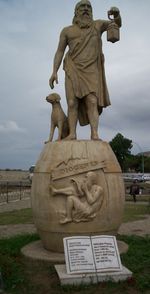
- ديوجنيس من سينوپه، الفيلسوف
- مثريداتس السادس (132-63 ق.م.)، ملك من پونطس
- مارقيون من سينوپه
- أكويلا من سينوپه
- فوكاس من سينوپه، (ت. 117 أو 303 م) قديس مسيحي
- سيدي علي ريس، أمير البحار العثماني، وكان كاتباً وعالماً، وقد وُلِد في عائلة أصلها من سينوپ.
- هاكان اونسال
- أحمد محب ديراناس، الشاعر التركي
- نجم الدين إربكان، السياسي الإسلامي
- Gökçe Akyıldız (1992-), actress
- Ayça Ayşin Turan (1992-) actress
متفرقات
سينوپ منحت اسمها للساتل الخارجي لكوكب المشترى.
سينوپ منحت اسمها لفوهة على سطح المريخ.
علاقات دولية
المدن الشقيقة
سينوب لها 9 مدن شقيقة:
 موسيون، النرويج
موسيون، النرويج يارڤه, إستونيا
يارڤه, إستونيا سوانزي, المملكة المتحدة
سوانزي, المملكة المتحدة ڤارنا, بلغاريا
ڤارنا, بلغاريا حاديبو، سقطرى، اليمن
حاديبو، سقطرى، اليمن إزكي، المنطقة الداخلية، عُمان
إزكي، المنطقة الداخلية، عُمان مورمانسك, روسيا
مورمانسك, روسيا ليون, فرنسا
ليون, فرنسا تشورلو, تركيا
تشورلو, تركيا
انظر أيضاً
وصلات خارجية
- Official Web Site of Sinop
- Sinop VR Photography
- MA in Black Sea Cultural Studies. International Hellenic University-School of Humanities
الهامش
- John Garstang, The Hittite Empire (University Press, Edinburgh, 1930).
- ^ "Area of regions (including lakes), km²". Regional Statistics Database. Turkish Statistical Institute. 2002. Retrieved 2013-03-05.
- ^ "Population of province/district centers and towns/villages by districts - 2012". Address Based Population Registration System (ABPRS) Database. Turkish Statistical Institute. Retrieved 2013-02-27.
- ^ İl Belediyesi, Turkey Civil Administration Departments Inventory. Retrieved 22 May 2023.
- ^ "Address-based population registration system (ADNKS) results dated 31 December 2022, Favorite Reports" (XLS) (in الإنجليزية). TÜİK. Retrieved 22 May 2023.
- ^ أ ب ت ث Doonan, Owen P. (2004). "Colonizing the Lands of Sinop". Sinop Landscapes: Exploring Connection in a Black Sea Hinterland. University of Pennsylvania Press, University of Pennsylvania Museum of Archaeology and Anthropology. pp. 69–92. ISBN 9781931707657. JSTOR j.ctt3fj358.11.
- ^ M. I. Maksimova (1951). "Hittites in the Black Sea Region". Journal of Near Eastern Studies. 10 (2): 74–81. doi:10.1086/371024. JSTOR 542257. S2CID 162233229.
- ^ See Strabo XII.iii.1 1; Diodorus Siculus, Historical Library 14.31.2; Pseudo-Scymnus 995-96; Eusebius, Chronographia 631/30 BCE; See also Doonan, Sinop Landscapes p. 71 for details of archaeological research
- ^ Thompson, Daniel V. (1956). The Materials and Techniques of Medieval Painting. New York: Dover Publications. ISBN 0-486-20327-1.
- ^ Gorman, Vanessa B. (2001). Miletos, the Ornament of Ionia: A History of the City to 400 B.C.E. University of Michigan Press. pp. 63–66. ISBN 978-0-472-11199-2.
- ^ Drews, Robert (1976). "The earliest Greek settlements on the Black Sea". The Journal of Hellenic Studies. 96: 18–31. doi:10.2307/631221. JSTOR 631221. S2CID 162253005.
- ^ Tezgör, Dominique Kassab (2011-10-06). Sinope, The Results of Fifteen Years of Research. Proceedings of the International Symposium, 7-9 May 2009: Sinope, Un état de la question après quinze ans de travaux. Actes du Symposium International, 7-9 May 2009. BRILL. ISBN 978-90-04-22388-2.
- ^ A. KAKHIDZE; I. IASHVILI; M. VICKERS (2001). "Silver Coins of Black Sea Coastal Cities from the Fifth Century BC Necropolis at Pichvnari". The Numismatic Chronicle. 16: 282–287. JSTOR 42668025.
- ^ See Polynaeus, Strategematon VII.21
- ^ أ ب ت Broughton, Thomas Robert Shannon; Mitchell, Stephen (2005). "Sinope". The Oxford Classical Dictionary. Oxford University Press. ISBN 978-0-19-860641-3. Retrieved 2018-05-15.
- ^ أ ب ت ث Foss, Clive (1991). "Sinope". In Kazhdan, Alexander (ed.). The Oxford Dictionary of Byzantium. Oxford and New York: Oxford University Press. p. 1904. ISBN 978-0-19-504652-6.
- ^ Vasiliev, V. V. (1936). "The Foundation of the Empire of Trebizond (1204-1222)". Speculum. 11 (1): 26–29. doi:10.2307/2846872. JSTOR 2846872. S2CID 162791512.
- ^ Runciman, Steven (1969). The Fall of Constantinople. London: Cambridge. p. 174.
- ^ Battutah, Ibn (2002). The Travels of Ibn Battutah. London: Picador. p. 118. ISBN 9780330418799.
- ^ Ostapchuk, Victor (2001). "The Human Landscape of the Ottoman Black Sea in the Face of the Cossack Naval Raids". Oriente Moderno. 20: 44–7.
- ^ Prothero, G. W. (1920). Anatolia. London: H.M. Stationery Office.
- ^ "Ayancık Hava Radarının Tarihini Biliyor Musunuz? | Ayancık Gazetesi". www.ayancikgazetesi.com (in التركية). 2020-11-24. Retrieved 2022-04-23.
- ^ J.G.F. HIND (2007). "City Heads/Personifications and Omens from Zeus (the Coins of Sinope, Istria and Olbia in the V-IV Centuries BC)". The Numismatic Chronicle. 16: 9–22. JSTOR 42666926.
- ^ Cynthia M. Harrison (1982). "Persian Names on Coins of Northern Anatolia". Journal of Near Eastern Studies. 41 (3): 181–194. doi:10.1086/372949. JSTOR 544997. S2CID 162353204.
- ^ "Resmi İstatistikler: İllerimize Ait Mevism Normalleri (1991–2020)" (in التركية). Turkish State Meteorological Service. Retrieved 24 April 2021.
- ^ "Sinop, Turkey Travel Weather Averages (Weatherbase)".
- ^ Prothero, G. W. (1920). Anatolia. London: H.M. Stationery Office. p. 112.
- ^ "2 Japanese companies aim to fund 30% of Turkish nuclear project". Nikkei Asian Review. Nikkei. 8 June 2015. Retrieved 9 June 2015.
- ^ "Sinop". karalahana.com. Archived from the original on 11 مايو 2012.
- ^ "About Sinop". karalahana.com. Archived from the original on 11 مايو 2012.
- ^ أ ب ت خطأ استشهاد: وسم
<ref>غير صحيح؛ لا نص تم توفيره للمراجع المسماةsam1 - ^ خطأ استشهاد: وسم
<ref>غير صحيح؛ لا نص تم توفيره للمراجع المسماةm - ^ أ ب خطأ استشهاد: وسم
<ref>غير صحيح؛ لا نص تم توفيره للمراجع المسماةskt1 - ^ خطأ استشهاد: وسم
<ref>غير صحيح؛ لا نص تم توفيره للمراجع المسماةskt2 - ^ خطأ استشهاد: وسم
<ref>غير صحيح؛ لا نص تم توفيره للمراجع المسماةsam2 - ^ خطأ استشهاد: وسم
<ref>غير صحيح؛ لا نص تم توفيره للمراجع المسماةskt3 - ^ خطأ استشهاد: وسم
<ref>غير صحيح؛ لا نص تم توفيره للمراجع المسماةsam3 - ^ خطأ استشهاد: وسم
<ref>غير صحيح؛ لا نص تم توفيره للمراجع المسماةrs
- Pages using gadget WikiMiniAtlas
- Short description is different from Wikidata
- Coordinates on Wikidata
- Articles containing Greek-language text
- Pages using Lang-xx templates
- محافظة سينوپ
- مدن تركيا
- منطقة البحر الأسود
- Populated places in Sinop Province
- سينوپ
- Populated coastal places in Turkey
- مواقع يونانية قديمة في تركيا
- Roman towns and cities in Turkey
- Paphlagonia
- موانئ البحر الأسود في تركيا
- بذرة تركيا
- CS1 التركية-language sources (tr)

